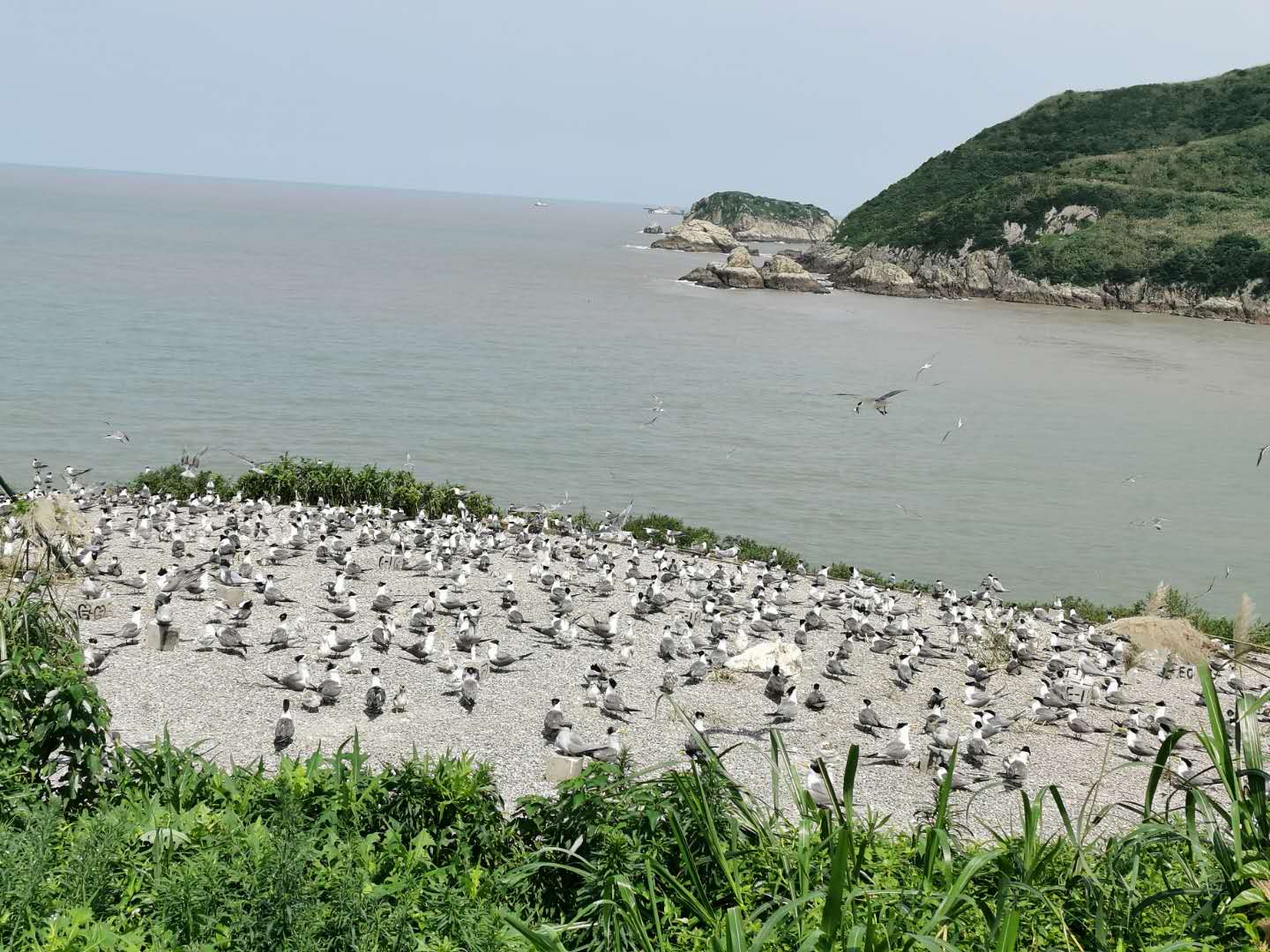The Chinese Crested Tern (Thalasseus bernsteini) is one of the most endangered seabird species, whose breeding range is restricted to the East China Sea and the Yellow Sea.

Chinese Crested Tern ©Yongdong Xie
Chinese Crested Tern was first discovered in Indonesia in 1861. After that, only a limited number of Chinese Crested Tern specimens were collected in Malaysia, the Philippines, Thailand and China (Shandong and Fujian Province). The last confirmed record was in the Moguan Island and Jiaozhou Bay in Qingdao, Shandong Province in 1937. The species then seemed to disappear for such a long time that many ornithologists believed it was indeed extinct. Sixty-three years later, in 2000, it was rediscovered in the Mazu islands. Due to its rarity and limited knowledge of its behavior, it was given the name, ‘the Bird of Mystery’.
The population of Chinese Crested Tern showed a big fluctuation from year to year due to the unstable condition of the breeding sites, mostly caused by human activities (such as egg poaching, shellfish collecting by fishermen, island exploitation and environmental pollution). In order to protect this critically endangered seabird, research team of Zhejiang Museum of Natural History, leading by Dr. Shuihua Chen and cooperating with Dr. Daniel Roby from the Oregon State University, initiated the tern restoration project using social attraction technique in Jiushan Islands National Nature Reserve, Xiangshan County, Ningbo City in 2013. The technique is based on a typical behavior of terns which usually breed in colony and their nesting behaviors can be easily influenced by peers choice. By placing decoys and using sound playback, the team intended to attract the passing terns to land and breed at chosen sites. This technique was invented in 1970s by American Ornithologist Dr. Steve Kress, has been used in at least 171 different seabird restoration projects conducted in 16 countries/regions in an attempt to conserve and restore population of at least 64 seabird species.
.jpg)
2013 tern project site ©Peng Ding
Tiedun Islet (in Jiushan Archipelago, Ningbo, Zhejiang Provicne) was chosen by research team as the tern restoration site in 2013. Nesting ground was well-designed: 400 tern decoys and two solar-powered playback system were deployed before breeding season. The technique quickly paid off: at least 3300 Greater Crested Terns and 19 Chinese Crested Terns were attracted to the site in middle July, and nearly half of them began to breed. Eventually more than 600 Greater Crested Tern chicks and at least 1 Chinese Crested Tern chick successfully fledged in October. The project achieved a big success in the first year. Since 2015, research team conducted the social attraction programs on Jiushan Archipelago and Wuzhishan Archipelago simultaneously and has made continuous success. As a result, the population of Chinese Crested Tern has gradually increased by years. By the end of the breeding season in 2018, the number of Chinese Crested Tern has increased from less than 50 before 2010 to more than 100 individuals.
The major advantage of the application of social attraction technique is to establish a strictly monitored and protected breeding population and to ensure its breeding success. Besides, this technique allows monitors observing terns closely without disturbing them, which is helpful to detect the potential threats to the breeding colony. Higher reproduction rate is expected by eliminating these threats. Moreover, new technique had drowned much public attention and greatly enhanced public conservation awareness of this critically endangered species. In the future, with the populations of both Greater Crested Terns and Chinese Crested Terns apparently increasing, more new breeding colonies could be created using social attraction. By persisting in this approach, a well-protected, closely monitored, and extensive conservation network of tern breeding islands could be developed in the East China Sea, and potentially in the Yellow Sea as well, where the Chinese crested tern was originally described.
This project is the first attempt in China that attracts seabirds to nest on a site chosen by human. It promises to provide much valuable experience for the conservation of breeding seabirds and facilitate seabird restoration throughout China. This success would also provide a new way for wildlife conservation and nature reserve management in China.
The research and results were published online at biological conservation, and is open access and available at: https://doi.org/10.1016/j.biocon.2020.108694.
.jpg)
Project site of Chinese Crested Tern breeding site ©Shuihua Chen
.jpg)
Juvenile Chinese Crested Tern fledging in 2013 ©Zhongyong Fan

Chinese Crested Tern ©Zhongyong Fan

Breeding Site of Chinese Crested Tern ©Teng Fang

Chinese Crested Tern ©Zhiwen Yan
Prepared by research team from Zhejiang Museum of Natural History
应用社群吸引技术恢复极危鸟类中华凤头燕鸥种群
中华凤头燕鸥(Thalasseus bernsteini)是世界上最为濒危的鸟类之一,被世界自然保护联盟濒危物种红色名录列为极度濒危物种,仅在东海和黄海繁殖。该物种1861年首次记录于印度尼西亚,后来在马来西亚、菲律宾、泰国和中国的山东和福建等地零星采集到标本。上世纪最后一次确切记录是1937年,在山东青岛外海的沐官岛和胶州湾的沧口。之后该物种一度消失,以致于许多鸟类学家认为已经灭绝,直至2000年在马祖列岛被重新发现。由于其数量稀少、行踪神秘,又被称为“神话之鸟”。

中华凤头燕鸥 ©谢勇东摄
由于受到人为捡蛋、渔民采贝、栖息地丧失、环境污染等因素的影响,中华凤头燕鸥的种群数量波动很大,繁殖地点也不固定。为了保护这一濒临灭绝的鸟类,浙江自然博物院的研究团队在陈水华博士带领下,从2013年开始,与美国俄勒冈州立大学Daniel Roby教授合作,首先在宁波市象山县韭山列岛国家级自然保护区开展人工招引鸟类试验。即采用社群吸引技术,利用燕鸥集群繁殖的习性,通过放置燕鸥假鸟模型、播放燕鸥鸣声,吸引中华凤头燕鸥和大凤头燕鸥到特定的栖息地繁殖。这项技术自20世纪70年代由美国鸟类学家Steve Kress博士发明以来,被广泛应用于海鸟恢复和保护项目,目前至少在16个国家和地区171个不同海鸟恢复项目中应用了这项技术,至少64种海鸟种群得以保护和恢复。
2013年繁殖季前,项目组选择韭山列岛国家级自然保护区内的中铁墩屿作为中华凤头燕鸥招引岛屿,清理栖息地后布置了400只假鸟,并播放燕鸥鸣声。7月中旬,燕鸥陆续被吸引来下蛋繁殖,到8月中旬至少吸引了3300只大凤头燕鸥和19只中华凤头燕鸥,到繁殖期末至少600只大凤头雏鸟、1只中华凤头鸥雏鸟出飞。招引项目首次实施即取得成功。从2015年开始,招引在象山韭山列岛和定海五峙山列岛同时开展,并取得连年成功,中华凤头燕鸥种群数量也逐年增长。到2018年繁殖季末,中华凤头燕鸥的数量从2010年的不足50只增长到超过了100只。
.jpg)
2013年7月下旬燕鸥开始陆续光临招引区 ©丁鹏摄
社群吸引技术的应用,最大的优点在于:可以借此建立一个可严格监测和保护的繁殖种群,确保繁殖群成功;其次,近距离监测也有利于发现潜在的威胁,通过消除威胁,逐步提高繁殖成功率;而且,这项技术也提供了一个友好安全的人鸟界面,具有广泛良好的社会宣传效应。未来,随着种群的扩大,可以继续利用社群吸引技术,在新的地点建立新的繁殖群,逐步构建起一个严格监测下的中华凤头燕鸥保护网络,最终有希望将中华凤头燕鸥从灭绝的边缘拉回,逐步复壮其种群数量。
中华凤头燕鸥种群人工招引与恢复项目是中国首个人工引导鸟类选择繁殖地试验。试验的成功为中国濒危动物的保护提供了新的思路和模式,是中国野生动物保护和自然保护区管理的一次有益探索和实践。相信该研究成果的发表和应用,将推动中国沿海中华凤头燕鸥及其他繁殖海鸟的保护,为中国海岸带生态系统的保护和恢复带来希望。
该项研究和实验成果近日在线发表于国际保护生物学主流杂志 Biological Conservation,论文链接:https://doi.org/10.1016/j.biocon.2020.108694。
.jpg)
2018年繁殖区,周边建有三个监测屋和一个视频监控探头 ©陈水华摄
.jpg)
2013年在铁墩岛繁殖的中华凤头燕鸥幼鸟成功出飞 ©范忠勇 摄

中华凤头燕鸥 ©范忠勇 摄

繁殖场 ©方腾

中华凤头燕鸥 ©严志文
文章由浙江自然博物院研究团队撰写




